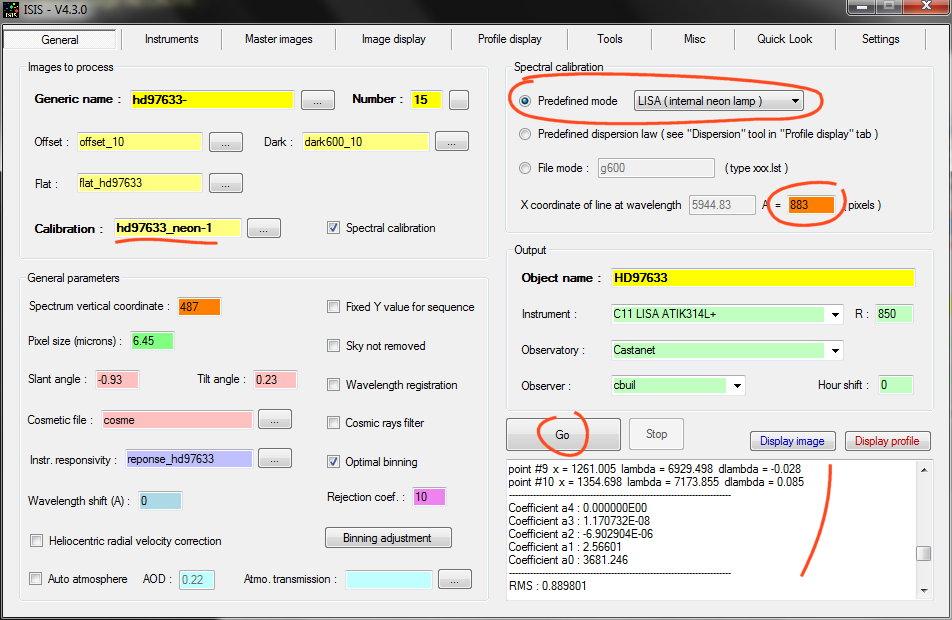Dear All
I have been using LISA to process images taken with my LISA. I have been selecting the "predefined Mode" LISA int neon lamp. This seems to be giving accurate results but I would like confirmation.
I have been taking 10sec exposures x 5 and combining them. This doesn't seem to saturate the image. This is then saved as the neon calibration frame.
When I look at the text data produced it creates results like this below.
Dispersion primaire :
Coefficient a4 : 0.000000E00
Coefficient a3 : 0.000000E00
Coefficient a2 : -6.961011E-07
Coefficient a1 : 0.28662
Coefficient a0 : -1083.492
--------------------------------------------------------------------------
RMS : 0.353241 (en pixels)
--------------------------------------------------------------------------
Ecart d'ajustement sur les points primaires :
point #1 Lambda = 3889.050 px = 20.662 dx = 0.121
point #2 Lambda = 3970.080 px = 43.444 dx = -0.444
point #3 Lambda = 4101.750 px = 80.443 dx = 0.182
point #4 Lambda = 4340.480 px = 147.466 dx = 0.168
point #5 Lambda = 4861.340 px = 293.419 dx = 0.056
point #6 Lambda = 6562.810 px = 767.565 dx = -0.373
point #7 Lambda = 6868.000 px = 852.185 dx = 0.290
--------------------------------------------------------------------------
Loi de dispersion inverse
Coefficient a4 : 0.000000E00
Coefficient a3 : 1.093406E-08
Coefficient a2 : 8.859178E-06
Coefficient a1 : 3.55356
Coefficient a0 : 2734.250
--------------------------------------------------------------------------
RMS : 0.840088 (en angstroms)
--------------------------------------------------------------------------
Ecart d'ajustement en longueur d'onde
point #1 x = 367.920 lambda = 4043.422 dlambda = -0.532
point #2 x = 428.216 lambda = 4258.426 dlambda = 0.934
point #3 x = 667.949 lambda = 5115.058 dlambda = -1.388
point #4 x = 747.424 lambda = 5399.782 dlambda = 0.778
point #5 x = 899.135 lambda = 5944.495 dlambda = 0.335
point #6 x = 922.844 lambda = 6029.772 dlambda = 0.228
point #7 x = 974.916 lambda = 6217.229 dlambda = 0.051
point #8 x = 1080.864 lambda = 6599.325 dlambda = -0.375
point #9 x = 1172.286 lambda = 6929.831 dlambda = -0.361
point #10 x = 1239.579 lambda = 7173.611 dlambda = 0.329
--------------------------------------------------------------------------
Coefficient a4 : 0.000000E00
Coefficient a3 : 1.093406E-08
Coefficient a2 : 8.859178E-06
Coefficient a1 : 3.55356
Coefficient a0 : 2734.250
--------------------------------------------------------------------------
RMS : 0.840088
How do I tell whether the calibration routine has selected the correct lines?
How do I tell which lines it has selected?
The numbers above do not seem to match the wavelength measurements for neon in the ISIS reference picture. ?why
Is there a better way of calibrating?
I can take a spectra of an A star and use the lines in it as well but do I then still use the internal neon predefined mode?
Sorry for all the questions but I'm finding this a bit confusing.
Cheers
Terry
Question about ISIS 4.2.0 and calibration
-
Terry Bohlsen
- Posts: 191
- Joined: Thu Sep 29, 2011 7:40 am
Question about ISIS 4.2.0 and calibration
Terry Bohlsen
Armidale NSW
Australia
Armidale NSW
Australia
-
Christian Buil
- Posts: 1431
- Joined: Mon Sep 26, 2011 6:59 pm
- Contact:
Re: Question about ISIS 4.2.0 and calibration
Terry,
Your spectral calibration by using only internal neon lamp look very well. Here, a comparison with a typical comparison by using my proper data (very similar result):

ISIS use here the following neon + argon line set (laboratory wavelength):
4042.89 (Ar)
4259.36 (Ar)
5113.67 (Ne)
5400.56 (Ne)
5944.83 (Ne)
6030.00 (Ne)
6217.28 (Ne)
6598.95 (Ne)
6929.47 (Ne)
7173.94 (Ne)
More explanation here (sorry in french):
http://www.astrosurf.com/buil/isis/lisa_start/index.htm
The interest of a mix calibration (A star + neon) is the improvement of spectral calibration
(0,8 Angstroms RMS typical error by using only the internal neon lamp, and 0,1 to 0,2 A RMS
errror only by using the mix method - important for serious works).
Christian Buil
Your spectral calibration by using only internal neon lamp look very well. Here, a comparison with a typical comparison by using my proper data (very similar result):

ISIS use here the following neon + argon line set (laboratory wavelength):
4042.89 (Ar)
4259.36 (Ar)
5113.67 (Ne)
5400.56 (Ne)
5944.83 (Ne)
6030.00 (Ne)
6217.28 (Ne)
6598.95 (Ne)
6929.47 (Ne)
7173.94 (Ne)
More explanation here (sorry in french):
http://www.astrosurf.com/buil/isis/lisa_start/index.htm
The interest of a mix calibration (A star + neon) is the improvement of spectral calibration
(0,8 Angstroms RMS typical error by using only the internal neon lamp, and 0,1 to 0,2 A RMS
errror only by using the mix method - important for serious works).
Christian Buil
-
Robin Leadbeater
- Posts: 1932
- Joined: Mon Sep 26, 2011 4:41 pm
- Contact:
Re: Question about ISIS 4.2.0 and calibration
Hi Christian,Christian Buil wrote: The interest of a mix calibration (A star + neon) is the improvement of spectral calibration
(0,8 Angstroms RMS typical error by using only the internal neon lamp, and 0,1 to 0,2 A RMS
errror only by using the mix method - important for serious works).
Christian Buil
0.1A is only ~6km/s at H beta. The systematic errors due to the RV of the calibration star and the earth's motion will potentially be much greater than this.
Robin
LHIRES III #29 ATIK314 ALPY 600/200 ATIK428 Star Analyser 100/200 C11 EQ6
http://www.threehillsobservatory.co.uk
http://www.threehillsobservatory.co.uk